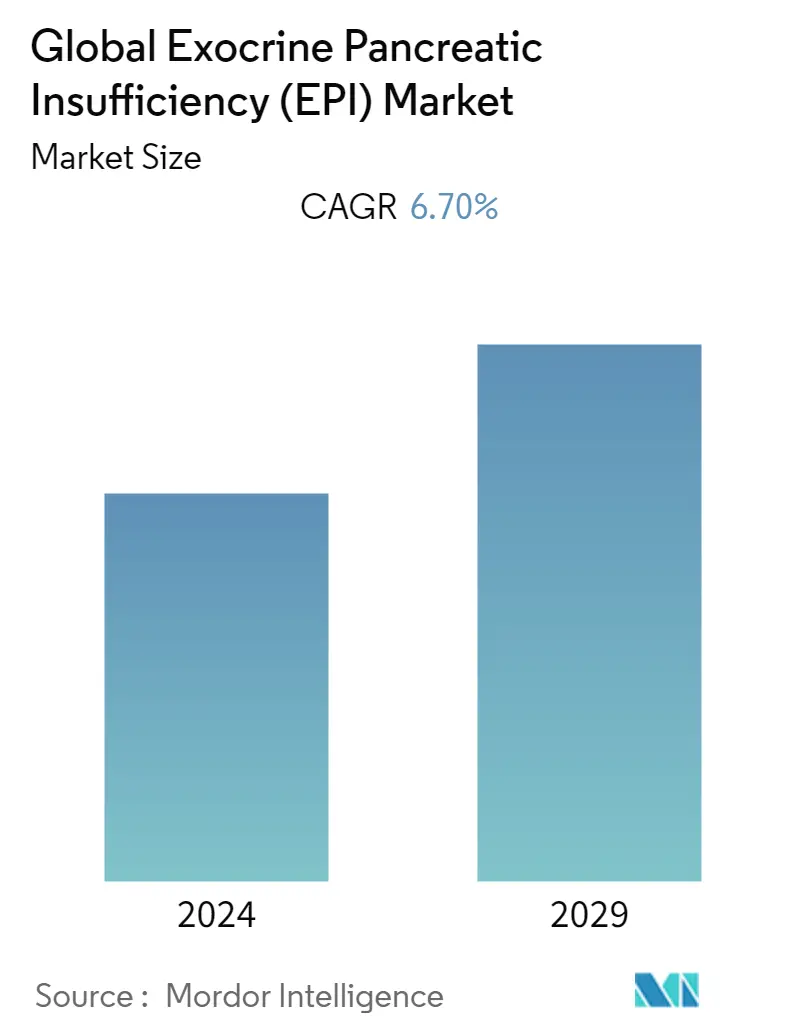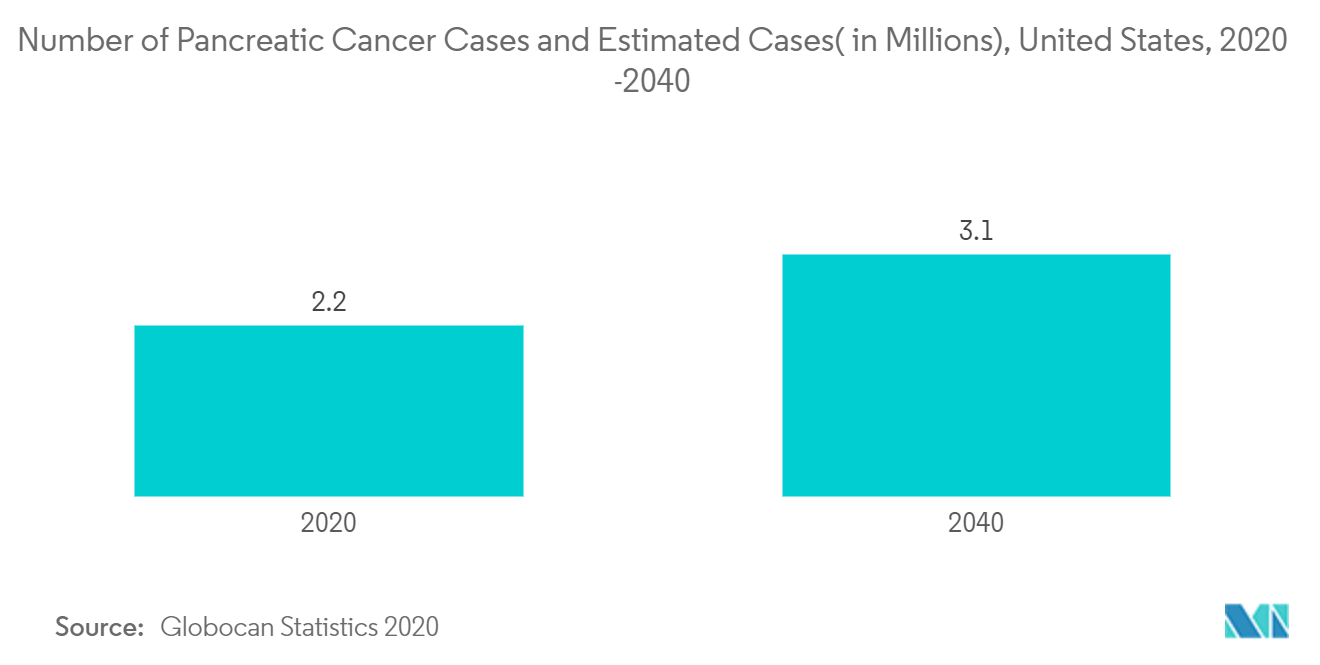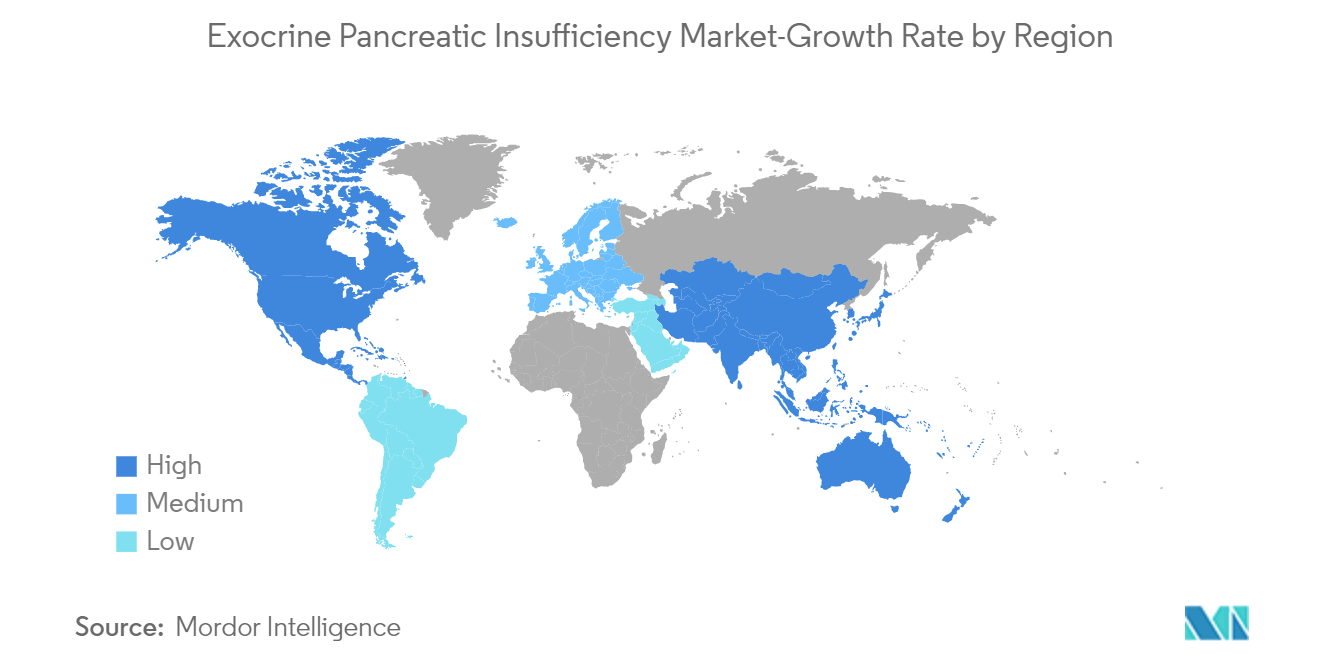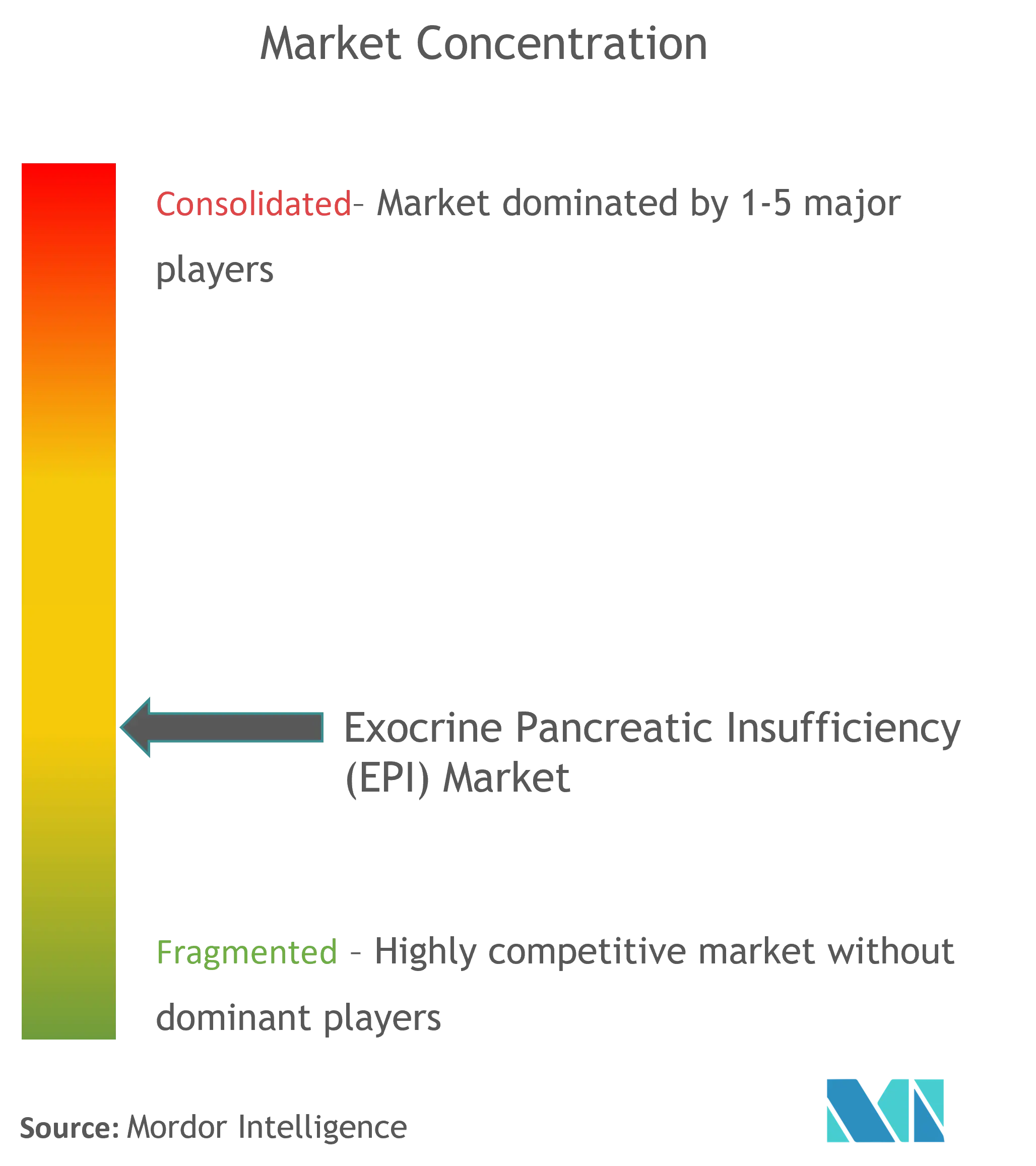Exocrine Pancreatic Insufficiency Market Size

| Study Period | 2019 - 2029 |
| Base Year For Estimation | 2023 |
| CAGR | 6.70 % |
| Fastest Growing Market | Asia-Pacific |
| Largest Market | North America |
| Market Concentration | High |
Major Players
*Disclaimer: Major Players sorted in no particular order |
Exocrine Pancreatic Insufficiency Market Analysis
The Exocrine pancreatic insufficiency (EPI) market is projected to register a CAGR of 6.7% during the forecast period (2022 - 2027).
Gastrointestinal symptoms, especially diarrhea, are common in infection with the novel coronavirus SARS-CoV-2. Angiotensin-converting enzyme-2 (ACE-2) receptors are highly expressed in enterocytes and serve as entry receptors for COVID-19. ACE-2 receptors may also be responsible for pancreatic damage in patients infected with SARS-CoV-2. According to a study conducted by Ni et al. 2020, both SARS-CoV and SARS-CoV-2 enter host cells via the angiotensin-converting enzyme 2 (ACE2) receptor, which is expressed in various human organs. For example, up to 67.0% of patients who developed diarrhea during SARS and a large number of patients with COVID-19 had intestinal symptoms. Diarrhea associated with SARS-CoV-2 is commonly thought to be caused by viral invasion of enterocytes. However, exocrine pancreatic insufficiency caused by SARS-CoV-2 is another likely mechanism leading to diarrhea in such patients. According to a study by Zippi et al., 2020, the gastrointestinal system can be affected by the infection of COVID-19, with a variable incidence from 3.0% to 79.0%. Therefore, the increasing number of cases of COVID-19 further leads to an increased number of cases of exocrine pancreatic insufficiency, and thus the market witnessed considerable growth during the pandemic.
Some of the factors driving the growth of the market include improved delivery system strategies. Bacterial engineering and gene transfer techniques could transform pancreatic enzyme delivery by producing enzymes in the host. Bacterial strains such as Lactococcus lactis - genetically modified to highly express bacterial lipases - have been derived. Several experiments are underway to demonstrate an effective delivery system, such as the colonization of subjects with experimentally induced pancreatic insufficiency with lipase-producing L. lactis, which has shown increased caffeic acid (CFA) on a high-fat diet.
The prevalence of exocrine pancreatic insufficiency is increasing majorly due to certain factors such as the increasing prevalence of the disease in cases of cystic fibrosis, chronic pancreatitis, and diabetes. Pancreatic insufficiency requires advanced therapeutics and the presence of a significant number of drugs. Recent trends in therapy include lipase therapy in dietetic patients and optimization of chymotrypsin and trypsin levels. However, in painful chronic exocrine pancreatitis, high-dose protease is thought to be beneficial. Severe cases are recommended for pancreatic replacement therapy along with pancreatin drugs. Esophagectomy was also associated with a rate of exocrine pancreatic insufficiency of 16.0%. Therefore, it is evident that exocrine pancreatic insufficiency can result in clinical manifestations and biochemical changes, causing reduced quality of life and life-threatening complications.
However, the treatment failure and lack of confidence in diagnosis and management are likely to impede the market growth over the forecast period.
Exocrine Pancreatic Insufficiency Market Trends
This section covers the major market trends shaping the Exocrine Pancreatic Insufficiency Market according to our research experts:
Pancreatic Enzyme Replacement Therapy (PERT) Segment is Expected to Witness Growth Over the Forecast Period
Pancreatic enzyme replacement therapy (PERT) is the first-line therapy for patients with exocrine pancreatic insufficiency and is expected to hold the largest market share in the therapies segment. PERT is safe and effective in the treatment of pancreatic exocrine insufficiency. PERT includes various classes of drugs that are currently in use, including Pancrease, Creon, Pertzye, Viokace, and Zenpep. Since 2010, the Food and Drug Administration has approved various pancreatic enzyme replacement products for the treatment of exocrine pancreatic insufficiency. Therefore the majority of drugs comprise porcine pancreas extracts (pancrelipase). All but one of these preparations have a delayed release (Creon, Pancreaze, Zenpep, Pertzie), majorly due to enteric beads that protect the lipase from denaturation by stomach acid.
According to the study titled, 'Pancreatic Enzyme Replacement Therapy in Patients Undergoing First-Line Gemcitabine Plus nab-paclitaxel for Advanced Pancreatic Adenocarcinoma' in September 2021, Pancreatic enzyme replacement therapy (PERT) is associated with significantly prolonged survival and amelioration of maldigestion-related symptoms in patients with advanced pancreatic ductal adenocarcinoma (PDAC). In addition, since optimal PERT therapy is based on its clinical efficacy, the initial dose may be doubled or tripled based on clinical need and results. Indeed, PERT has demonstrated acceptable safety and tolerability over time, with reported side effects being abdominal pain, abdominal distension, and diarrhea.
Since pancreatic enzyme replacement therapy (PERT) therapy is safe and effective, as well as standard care for people with exocrine pancreatic insufficiency, therefore, considerable segment growth is anticipated over the forecast period.

North America is Expected to Dominate the Exocrine Pancreatic Insufficiency (EPI) Market
North America is expected to account for a significant share of the global exocrine pancreatic insufficiency (EPI) market due to the rise in the geriatric population and increasing prevalence and incidence of infectious diseases in the region. According to the study titled "Pancreatic Insufficiency," published in May 2022, excess alcohol is a well-known cause of chronic pancreatitis. Therefore, heavy drinkers have three times the risk of developing chronic pancreatitis, and the risk is further expected to increase among drinkers who are heavy smokers as well. Therefore, the high adoption of a sedentary lifestyle in this region is one of the major reasons for the high prevalence of chronic pancreatitis. For instance, according to the report published by the National Center for Drug Abuse Statistics in 2021, approximately 60.0% of Americans increased their alcohol consumption during the COVID-19 lockdown.
Key product launches, high concentration of market players or manufacturer's presence, acquisition and & partnerships among major players, and high prevalence of chronic pancreatitis in the United States are some of the factors driving the growth of the exocrine pancreatic insufficiency (EPI) market in the country. For instance, as per the study titled "Pancreatic Insufficiency," published in May 2022, chronic pancreatitis occurs in about 42 to 73 per 100,000 population in the United States and is the most common pancreatic disorder associated with pancreatic insufficiency, compared to 36 to 125 per 100,000 population in Japan, China, and India.
Therefore, owing to the aforesaid factors, considerable growth of the studied market is anticipated in the North America Region.

Exocrine Pancreatic Insufficiency Industry Overview
The exocrine pancreatic insufficiency market is fragmented and competitive and consists of several major players. In terms of market share, a few of the major players are currently dominating the market. The competitive landscape includes an analysis of a few international as well as local companies which hold the market shares and are well known, including Digestive Care, AbbVie, Nestle, Alcresta Therapeutics, First Wave BioPharma, Chiesi Pharmaceuticals, Vivus, Aimmune Therapeutics, PerseoPharma, Codexis, Synspira Therapeutics, among others.
Exocrine Pancreatic Insufficiency Market Leaders
-
Digestive Care
-
AbbVie
-
Nestle
-
Alcresta Therapeutics
-
First Wave BioPharma
*Disclaimer: Major Players sorted in no particular order

Exocrine Pancreatic Insufficiency Market News
- In April 2022, Alcresta Therapeutics, Inc., a leading commercial-stage company focused on developing and commercializing novel enzyme-based products, announced a series of commercial milestone achievements for RELiZORB.
- In February 2022, investigators at the University of Miami surveyed patients about their experience using pancreatic enzyme replacement therapy (PERT) and found education about this treatment is lacking.
Exocrine Pancreatic Insufficiency Market Report - Table of Contents
1. INTRODUCTION
- 1.1 Study Assumptions and Market Defination
- 1.2 Scope of the Study
2. RESEARCH METHODOLOGY
3. EXECUTIVE SUMMARY
4. MARKET DYNAMICS
- 4.1 Market Overview
-
4.2 Market Drivers
- 4.2.1 Increasing Cases of Exocrine Pancreatic Insufficiency
- 4.2.2 Demands of Advanced Therapeutics and Improved Drug Delivery System
-
4.3 Market Restraints
- 4.3.1 Treatment Failure and Lack of Confidence in Diagnosis and Management
-
4.4 Porter's Five Forces Analysis
- 4.4.1 Threat of New Entrants
- 4.4.2 Bargaining Power of Buyers/Consumers
- 4.4.3 Bargaining Power of Suppliers
- 4.4.4 Threat of Substitute Products
- 4.4.5 Intensity of Competitive Rivalry
5. MARKET SEGMENTATION
-
5.1 By Therapies
- 5.1.1 Pancreatic exocrine replacement therapies (PERT)
- 5.1.2 Nutritional Therapy (Dietry suppliments)
-
5.2 By Distribution Channel
- 5.2.1 Hospital Pharmacies
- 5.2.2 Retail Pharmacies
- 5.2.3 Others
-
5.3 Geography
- 5.3.1 North America
- 5.3.1.1 United States
- 5.3.1.2 Canada
- 5.3.1.3 Mexico
- 5.3.2 Europe
- 5.3.2.1 Germany
- 5.3.2.2 United Kingdom
- 5.3.2.3 France
- 5.3.2.4 Italy
- 5.3.2.5 Spain
- 5.3.2.6 Rest of Europe
- 5.3.3 Asia-Pacific
- 5.3.3.1 China
- 5.3.3.2 Japan
- 5.3.3.3 India
- 5.3.3.4 Australia
- 5.3.3.5 South Korea
- 5.3.3.6 Rest of Asia-Pacific
- 5.3.4 Middle-East and Africa
- 5.3.4.1 GCC
- 5.3.4.2 South Africa
- 5.3.4.3 Rest of Middle-East and Africa
- 5.3.5 South America
- 5.3.5.1 Brazil
- 5.3.5.2 Argentina
- 5.3.5.3 Rest of South America
6. COMPETITIVE LANDSCAPE
-
6.1 Company Profiles
- 6.1.1 Digestive Care
- 6.1.2 AbbVie
- 6.1.3 Nestle
- 6.1.4 Alcresta Therapeutics
- 6.1.5 First Wave BioPharma
- 6.1.6 Vivus
- 6.1.7 Perseo Pharma
- 6.1.8 Codexis
- 6.1.9 Synspira Therapeutics
- 6.1.10 Janssen Pharmaceuticals, Inc.
- *List Not Exhaustive
7. MARKET OPPORTUNITIES AND FUTURE TRENDS
** Subject To AvailablityExocrine Pancreatic Insufficiency Industry Segmentation
As per the scope of this report, exocrine pancreatic insufficiency is defined as an enzyme output less than 10.0% of the necessary level required to sustain normal digestion. Exocrine pancreatic insufficiency is mostly caused by diseases that destroy pancreatic parenchyma, such as chronic pancreatitis and cystic fibrosis, as well as pancreatic resection. The exocrine pancreatic insufficiency (EPI) Market is segmented by Therapies (Pancreatic exocrine replacement therapies (PERT), Nutritional Therapy (Dietary supplements)), By Distribution Channels (Hospital Pharmacies, Retail Pharmacies, and others), and Geography (North America, Europe, Asia-Pacific, Middle East & Africa, and South America). The market report also covers the estimated market sizes and trends for 17 different countries across major regions, globally. The report offers the value (in USD million) for the above segments.
| By Therapies | Pancreatic exocrine replacement therapies (PERT) | |
| Nutritional Therapy (Dietry suppliments) | ||
| By Distribution Channel | Hospital Pharmacies | |
| Retail Pharmacies | ||
| Others | ||
| Geography | North America | United States |
| Canada | ||
| Mexico | ||
| Geography | Europe | Germany |
| United Kingdom | ||
| France | ||
| Italy | ||
| Spain | ||
| Rest of Europe | ||
| Geography | Asia-Pacific | China |
| Japan | ||
| India | ||
| Australia | ||
| South Korea | ||
| Rest of Asia-Pacific | ||
| Geography | Middle-East and Africa | GCC |
| South Africa | ||
| Rest of Middle-East and Africa | ||
| Geography | South America | Brazil |
| Argentina | ||
| Rest of South America |
Exocrine Pancreatic Insufficiency Market Research FAQs
What is the current Global Exocrine Pancreatic Insufficiency (EPI) Market size?
The Global Exocrine Pancreatic Insufficiency (EPI) Market is projected to register a CAGR of 6.70% during the forecast period (2024-2029)
Who are the key players in Global Exocrine Pancreatic Insufficiency (EPI) Market?
Digestive Care, AbbVie, Nestle, Alcresta Therapeutics and First Wave BioPharma are the major companies operating in the Global Exocrine Pancreatic Insufficiency (EPI) Market.
Which is the fastest growing region in Global Exocrine Pancreatic Insufficiency (EPI) Market?
Asia-Pacific is estimated to grow at the highest CAGR over the forecast period (2024-2029).
Which region has the biggest share in Global Exocrine Pancreatic Insufficiency (EPI) Market?
In 2024, the North America accounts for the largest market share in Global Exocrine Pancreatic Insufficiency (EPI) Market.
What years does this Global Exocrine Pancreatic Insufficiency (EPI) Market cover?
The report covers the Global Exocrine Pancreatic Insufficiency (EPI) Market historical market size for years: 2019, 2020, 2021, 2022 and 2023. The report also forecasts the Global Exocrine Pancreatic Insufficiency (EPI) Market size for years: 2024, 2025, 2026, 2027, 2028 and 2029.
Global Exocrine Pancreatic Insufficiency (EPI) Industry Report
Statistics for the 2024 Global Exocrine Pancreatic Insufficiency (EPI) market share, size and revenue growth rate, created by Mordor Intelligence™ Industry Reports. Global Exocrine Pancreatic Insufficiency (EPI) analysis includes a market forecast outlook to 2029 and historical overview. Get a sample of this industry analysis as a free report PDF download.



